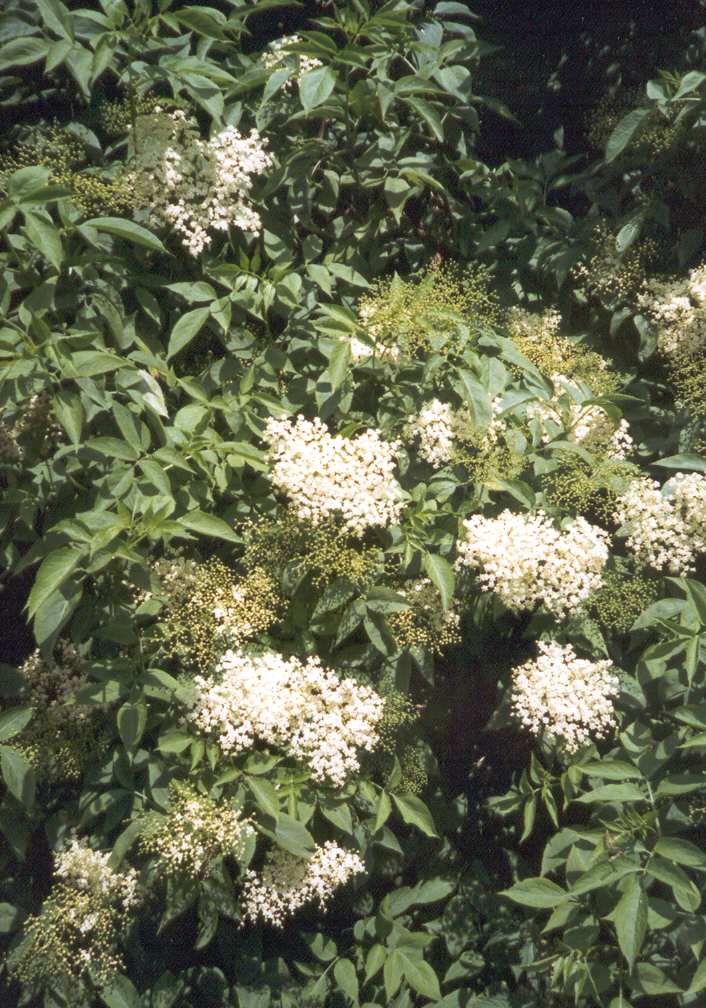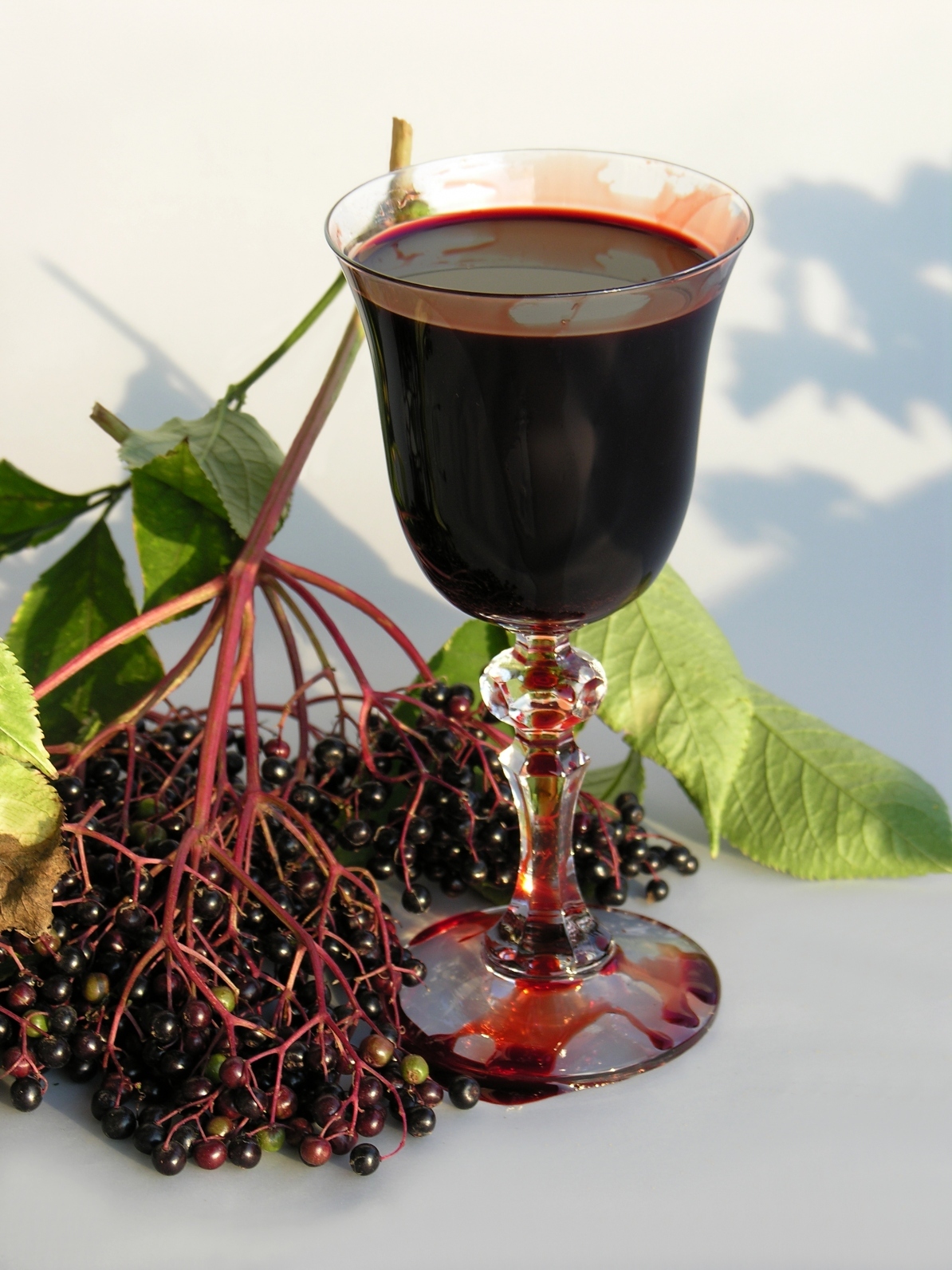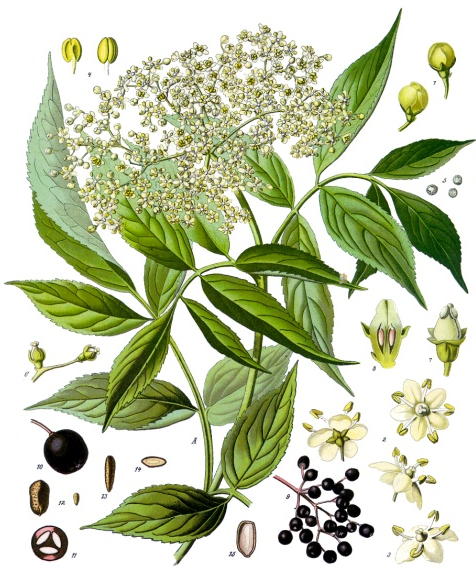
Sambucus nigra (L)
Synonyms and Common names: Sambucus, European elder, Black elder, Black-berried elder, Pipe tree, Common elder, Bore tree, Boor tree, Bourtree, Bountry, Ellanwood, Ellhorn, German elder, Aeldrum (Anglo-Saxon).
German = Holunder, French = Sureau, Spanish = Sauco, Italian = Sambreo
Order: Caprifoliaceae

Description: Sambucus is common throughout most of Europe and grows in hedgerows, woods, coppices and waste places throughout northern temperate regions. It is a wide-branched shrubby tree growing up to 10m in height with a trunk diameter of up to 30cm. The bark, light grey when young, changes to a coarse grey outer bark with lengthwise furrowing. The stiff, pithy annual shoots are light greyish-brown, the older branches brown. The opposite, oval pointed buds are covered in the lower part with reddish-brown scales from which green buds protrude. The opposite, odd-pinnate and petiolate leaves have two or three pairs of lateral leaflets, oval to tapering and coarsely-toothed, usually narrowing downwards into a wedge shape, and entire. The stalk has small glandular stipules at the base. The bisexual flowers, appearing in early summer, are arranged in rich, flat cymes. They have a short, bell-shaped calyx and a rounded corolla composed of creamy oval petals. There are five stamens. The ovary has a sessile stigma divided into three to five lobes, maturing into globular, glossy, blackish-purple drupes containing the seeds.
Parts used: Dried flowers, berries, inner bark, leaves
Collection: The flowers are gathered in spring and early summer; and should be dried rapidly in the shade. The berries are collected in August and September. The bark should be taken from young branches in early spring, before the leaves appear.
Constituents: Flowers: up to 3% flavonoids (including rutin, isoquercitrine and kaempherol), phenolic acids, triterpenes, triterpene acid, sterols, the hydrocyanic glycoside sambunigrine, traces of semi-solid yellow volatile oil, mucilage and tannins, sugar, 8-9% minerals (especially potassium), small quantity of essential oil (containing palmitic, linoleic and linolenic acids). Berries: Invert sugar, fruit acids, pectin, tannin, vitamin C, vitamin A, bioflavonoids, anthrocyanic pigments, traces of essential oil. Leaves: triterpenes, cyanogenetic glycosides (sambunigrin), flavonoids (rutin, quercetin), fats, fatty acids, sugars, alkanes, tannins, vitamins, resins. Bark: phytohaemagglutinins, alkaloid (sambucine), resin, viburnic acid, volatile oil, fat, wax, chlorophyll, tannic acid, gum, starch, pectin
Actions: Flowers: diaphoretic, anticatarrhal, expectorant, circulatory stimulant, diuretic, topically anti-inflammatory. Bark: purgative, emetic, diuretic, laxative, topical emollient. Leaves: externally as an emollient and vulnerary; internally as a purgative, expectorant, diuretic and diaphoretic. Berries: diaphoretic, diuretic, laxative
Indications: Flowers: Influenza, chronic nasal catarrh with deafness, sinusitis. Specifically indicated in the common cold.

Therapeutics and Pharmacology: The fresh flowers are diaphoretic when administered as a hot infusion. This action is less marked in the dried flowers due to the loss of much of the volatile oil component. The bioflavonoids stimulate the circulation, and Sambucus flowers, combined with Achillea and Mentha, are specific for the treatment of colds and influenza. Sambucus is indicated in any catarrhal inflammation of the upper respiratory tract, for example, allergic rhinitis or sinusitis and, taken prophylactically early in the year, strengthens the upper respiratory tract before the pollen count rises. The action of Sambucus in the upper respiratory system is further enhanced by its anti-inflammatory action. A cold, strained infusion of the flowers is a soothing remedy for inflamed eyes, and can be used as a gargle for mouth ulcers and tonsillitis. The flowers also have an expectorant action, thereby alleviating lung congestion; they also have a direct action one of the mechanisms involved in the production of mucus so that excess catarrh is checked. Sambucus is therefore beneficial in bronchitis and even pneumonia. The flowers are mildly relaxing and can be used where there is agitation and restlessness; there is a direct effect on the nervous system inducing relaxation of all visceral functions. Topically, they are often used in skin creams and for chilblains. An infusion made from Sambucus flowers, Hypericum herb and Saponaria root has exhibited anti-viral activity against influenza types A and B, both in vitro and in vivo, and herpes simplex virus Type I in vitro.
The berries have similar properties to the flowers. Rich in Vitamin C, a
syrup may be made from them to be taken as a prophylactic against
winter colds. Combined with expectorant Thymus, the berries are also useful in
the treatment of coughs. Sambucus’ diuretic and anti-inflammatory activity
helps explain its use in rheumatic and arthritic conditions. The
leaves, bark and berries have a greater diuretic activity than the flowers. The berries and bark have a long-established effect in regulating bowel
activity, moderating extremes of diarrhoea but also encouraging a substantial
movement if that is what is needed. The leaves are used topically to treat bruises, sprains, wounds, burns and
chilblains, and may also be used as a mouthwash. Recent research suggests that they may
be of use in an ointment for the treatment of tumours.
Combinations: The flowers may be combined with Achillea and Mentha piperata for colds and influenza, or with Achillea and/or Hyssopus in influenza. For catarrhal states Sambucus can be combined with Solidago.
Caution: The bark should not be used in pregnancy as it is a strong purgative while the unripe berries, young bark and leaves contain the toxic glycoside d-sambunigrin which can produce hydrocyanic acid.
Preparation and Dosage: (thrice daily)
GSL Schedule 1
Dried flowers: 3-5g or by infusion
Liquid Extract:1:1 in 25% alcohol, 3-5ml
Tincture: 1:5 in 25% alcohol, 10-25ml
Additional Comments: Elder is a traditional symbol of sorrow and death because it is the wood from which the crucifixion cross was made and the type of tree from which Judas hanged himself. It has magical associations throughout Europe where it is widely believed that burning elder wood brings bad luck, but that elder sprigs hung in houses provide protection from witches. Shakespeare refers to elder as a symbol of grief in Cymbeline. The Romans used elderberry juice as a hair dye and elderflower water used in the 18th century to whiten the skin and remove freckles. Elder produces green, violet and black dyes. An infusion of the leaves is quite an effective insecticide. The flowers and berries are widely used to make wines, cordials, desserts, jams and chutneys, and elderflower juice or wine is often taken in rural areas as a spring tonic. The Chinese prescribe elder for bone pain, swelling of the legs, muscular spasms and traumatic injuries.
Bibliography
Bartram, T. 1995 Encyclopedia of Herbal Medicine, 1st edn.,Grace Publishers, Bournemouth.
Bradley, P.R. (ed.) 1992 British Herbal Compendium, Volume 1, BHMA, Bournemouth.
Bremness, L. 1994 Herbs, Dorling Kindersley Eyewitness Handbook, London.
BHMA 1983 British Herbal Pharmacopoeia, BHMA, Bournemouth.
Chevallier, A. 1996 The Encyclopedia of Medicinal Plants, Dorling Kindersley, London.
Dyer, A. 1981 Dyes from Natural Sources, Bell & Hyman, London.
Grieve, M. 1931 A Modern Herbal, (ed. C.F. Leyel 1985), London.
Hoffmann, D. 1990 The New Holistic Herbal, Second Edition, Element, Shaftesbury.
Hyperhealth 1996 Natural Health and Nutrition Databank, v.96.1 CD-ROM, ©In-Tele-Health
Lust, J. 1990 The Herb Book, Bantam, London.
Mabey, R. (ed.) 1991 The Complete New Herbal, Penguin, London.
Mills, S.Y. 1993 The A-Z of Modern Herbalism, Diamond Books, London.
Newall, C.A., Anderson, L.A., & Phillipson, J.D. 1996 Herbal Medicines: A Guide for Health-care Professionals, The Pharmaceutical Press, London.
Ody, P. 1993 The Herb Society's Complete Medicinal Herbal, Dorling Kindersley, London.
Polunin, M. and Robbins, C. 1992 The Natural Pharmacy, Dorling Kindersley, London.
Prihoda, A. 1989 The Healing Powers of Nature, Octopus, London.
Weiss, R.F. 1991 Herbal Medicine, Beaconsfield Arcanum, Beaconsfield.
Wren, R.C. 1988 Potter's New Cyclopaedia of Botanical Drugs and Preparations, C.W.Daniel, Saffron Walden.










